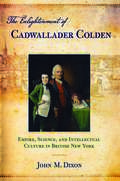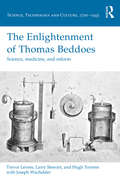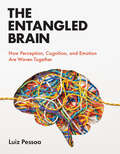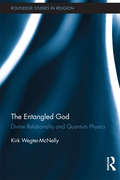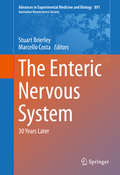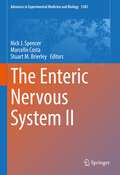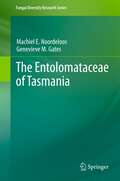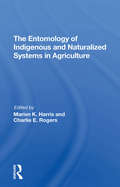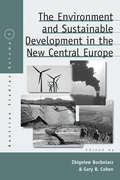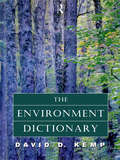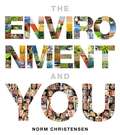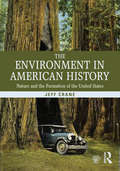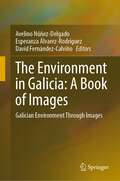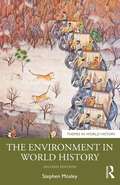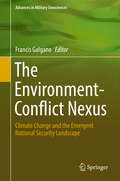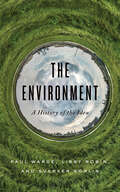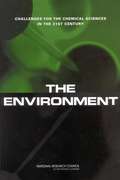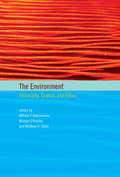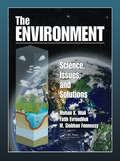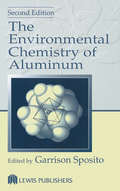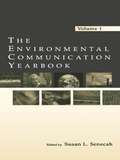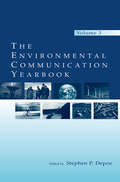- Table View
- List View
The Enlightenment of Cadwallader Colden: Empire, Science, and Intellectual Culture in British New York
by John M. DixonWas there a conservative Enlightenment? Could a self-proclaimed man of learning and progressive science also have been an agent of monarchy and reaction? Cadwallader Colden (1688-1776), an educated Scottish emigrant and powerful colonial politician, was at the forefront of American intellectual culture in the mid-eighteenth century. While living in rural New York, he recruited family, friends, servants, and slaves into multiple scientific ventures and built a transatlantic network of contacts and correspondents that included Benjamin Franklin and Carl Linnaeus. Over several decades, Colden pioneered colonial botany, produced new theories of animal and human physiology, authored an influential history of the Iroquois, and developed bold new principles of physics and an engaging explanation of the cause of gravity. The Enlightenment of Cadwallader Colden traces the life and ideas of this fascinating and controversial "gentleman-scholar." John M. Dixon's lively and accessible account explores the overlapping ideological, social, and political worlds of this earliest of New York intellectuals. Colden and other learned colonials used intellectual practices to assert their gentility and establish their social and political superiority, but their elitist claims to cultural authority remained flimsy and open to widespread local derision. Although Colden, who governed New York as an unpopular Crown loyalist during the imperial crises of the 1760s and 1770s, was brutally lampooned by the New York press, his scientific work, which was published in Europe, raised the international profile of American intellectualism.
The Enlightenment of Thomas Beddoes: Science, medicine, and reform (Science, Technology and Culture, 1700-1945)
by Larry Stewart Joseph Wachelder Trevor Levere Hugh TorrensThomas Beddoes (1760-1808) lived in ‘decidedly interesting times’ in which established orders in politics and science were challenged by revolutionary new ideas. Enthusiastically participating in the heady atmosphere of Enlightenment debate, Beddoes' career suffered from his radical views on politics and science. Denied a professorship at Oxford, he set up a medical practice in Bristol in 1793. Six years later - with support from a range of leading industrialists and scientists including the Wedgwoods, Erasmus Darwin, James Watt, James Keir and others associated with the Lunar Society - he established a Pneumatic Institution for investigating the therapeutic effects of breathing different kinds of ‘air’ on a wide spectrum of diseases. The treatment of the poor, gratis, was an important part of the Pneumatic Institution and Beddoes, who had long concerned himself with their moral and material well-being, published numerous pamphlets and small books about their education, wretched material circumstances, proper nutrition, and the importance of affordable medical facilities. Beddoes’ democratic political concerns reinforced his belief that chemistry and medicine should co-operate to ameliorate the conditions of the poor. But those concerns also polarized the medical profession and the wider community of academic chemists and physicians, many of whom became mistrustful of Beddoes’ projects due to his radical politics. Highlighting the breadth of Beddoes’ concerns in politics, chemistry, medicine, geology, and education (including the use of toys and models), this book reveals how his reforming and radical zeal were exemplified in every aspect of his public and professional life, and made for a remarkably coherent program of change. He was frequently a contrarian, but not without cause, as becomes apparent once he is viewed in the round, as part of the response to the politics and social pressures of the late Enlightenment.
The Entangled Brain: How Perception, Cognition, and Emotion Are Woven Together
by Luiz PessoaA new vision of the brain as a fully integrated, networked organ.Popular neuroscience accounts often focus on specific mind-brain aspects like addiction, cognition, or memory, but The Entangled Brain tackles a much bigger question: What kind of object is the brain? Neuroscientist Luiz Pessoa describes the brain as a highly networked, interconnected system that cannot be neatly decomposed into a set of independent parts. One can&’t point to the brain and say, &“This is where emotion happens&” (or any other mental faculty). Pessoa argues that only by understanding how large-scale neural circuits combine multiple and diverse signals can we truly appreciate how the brain supports the mind. Presenting the brain as an integrated organ and drawing on neuroscience, computation, mathematics, systems theory, and evolution, The Entangled Brain explains how brain functions result from cross-cutting brain processing, not the function of segregated areas. Parts of the brain work in a coordinated fashion across large-scale distributed networks in which disparate parts of the cortex and the subcortex work simultaneously to bring about behaviors. Pessoa intuitively explains the concepts needed to formalize this idea of the brain as a complex system and how to unleash powerful understandings built with &“collective computations.&”
The Entangled God: Divine Relationality and Quantum Physics (Routledge Studies in Religion)
by Kirk Wegter-McNellyIn The Entangled God, Kirk Wegter-McNelly addresses the age-old theological question of how God is present to the world by constructing a novel, scientifically informed account of the God–world relation. Drawing on recent scientific and philosophical work in "quantum entanglement," Wegter-McNelly develops the metaphor of "divine entanglement" to ground the relationality and freedom of physical process in the power of God’s relational being. The Entangled God makes a three-fold contribution to contemporary theological and religious discourse. First, it calls attention to the convergence of recent theology around the idea of "relationality." Second, it introduces theological and religious readers to the fascinating story of quantum entanglement. Third, it offers a robust "plerotic" alternative to kenotic accounts of God’s suffering presence in the world. Above all, this book takes us beyond the view of theology and science as adversaries and demonstrates the value of constructively relating these two important areas of intellectual investigation.
The Enteric Nervous System
by Stuart Brierley Marcello CostaNearly 30 years ago, a number of scientists working on the Enteric Nervous System (ENS) gathered at Flinders University, in Adelaide, Australia to discuss the advances and future of their research. It was a friendly and stimulating meeting, attended by most of the major players, in what was to become the discipline of 'Neurogastroenterology'. In 2014, the main Australasian Neuroscience Society meeting was held in Adelaide, Australia, providing the perfect opportunity to recreate a follow-up ENS meeting. As such, the 'ENS II 2014 meeting' aimed to identify how far the field of enteric neuroscience had developed, where the future was heading, and what technological advances had been made to address current and future unresolved questions. 30 speakers from around the world were invited to give talks and revisit the original expectations, the advances made since, and the future directions of ENS research. These discussions included three generations of investigators from 7 different countries. This publication represents the majority of proceedings from the 'The Enteric Nervous System II 2014' conference, which was held on February 1st - 2nd 2014 at the National Wine Centre of Australia, Adelaide. This meeting was an Official satellite meeting of the 34th Annual Meeting of Australasian Neuroscience Society, which was also held in Adelaide. The 20 contributions contained within this submission are from international researchers in the field of the ENS, who reviewed the advances made since the first meeting in the early 1980s and summarizes the present and future perspectives of neuro-gastroenterology. Some colleagues could not attend but did send greetings and their messages are included in these proceedings.
The Enteric Nervous System II (Advances in Experimental Medicine and Biology #1383)
by Marcello Costa Nick J. Spencer Stuart M. BrierleyThis book is based on the proceedings of the Enteric Nervous System conference in Adelaide, Australia, under the auspices of the International Federation for Neurogastroenterology and Motility. The book focuses on methodological strategies and unresolved issues in the field and explores where the future is heading and what technological advances have been made to address current and future questions. The Enteric Nervous System II continues in the tradition of a popular earlier volume which covered the previous meeting. Many of the same authors are contributing to this new volume, presenting state-of-the-art updates on the many developments in the field since the earlier meeting. The coverage include a wide range of topics, from structure and function of the enteric nervous system through gut motility and visceral pain. The author team includes long-established authorities who significantly contributed to the advances in ENS research over the past two decades and the new generation that will continue to contribute to advancing our understanding of the field.
The Entolomataceae of Tasmania
by Genevieve M. Gates Machiel NoordeloosThis book is the result of 14 years of collecting Entolomataceae in the native forests of Tasmania, Australia. Although initially involving only the Tasmanian residents Genevieve Gates and David Ratkowsky, who made twice- or thrice-weekly forays into the forests throughout the year, the project was subsequently joined by agaric specialist Machiel Noordeloos from the Netherlands, and by fungi photographer Michael Pilkington from the United Kingdom. The international character of the project is further evidenced by the earlier contributions of American mycologist Tim Baroni to the Tasmanian Rhodocybe species which form the basis of the chapter on the now-expanded concept of Clitopilus, and a visit of several months in 2010 by Brazilian Ph.D. candidate Fernanda Karstedt, who tested the keys to the Entoloma species. Consequently, several thousand well-annotated collections were found during this inventory and form the basis of this monographic treatment of the Entoloma and Clitopilus of Tasmania. The resulting 90 Entoloma species and 10 Clitopilus species are well documented with standardized descriptions, line drawings of fruit bodies and diagnostic microscopic characters, and, when available, with colour photographs. Thanks to the intensive search, it was possible to illustrate most species in colour. Dichotomous keys facilitate identification of the species. The species concept used is morphologically based; in several cases, however, identification to species level is supported by molecular data.
The Entomology Of Indigenous And Naturalized Systems In Agriculture
by Marvin K Harris Charlie E Rogers Carl ShanksThis book highlights some agriculturally important plants and their associated arthropod complexes with a biological, as well as an agricultural, perspective. It discusses how limited knowledge of entomology may be used to enhance management of pest species in cultivated sunflower.
The Environment And Sustainable Development In The New Central Europe (Austrian and Habsburg Studies #7)
by Gary B. Cohen Zbigniew BochniarzWith the enlargement of the European Union, the accession countries are coming under pressure to develop and meet EU standards for environmental protection and sustainable development. In this ongoing process, global economic liberalization, regulatory policy, conservation, and lifestyle issues are all involved, and creative solutions will have to be found. Historians, geographers, economists, ecologists, business management experts, public policy specialists, and community organizers have come together in this volume and examine, for the first time, environmental issues ranging from national and regional policy and macroeconomics to local studies in community regeneration. The evidence suggests that, far from being mere passive recipients of instruction and assistance from outside, the people of Central and East Central Europe have been engaged actively in working out solutions to these problems. Several promising cases illustrate opportunities to overcome crisis situations and offer examples of good practices, while others pose warnings. The experiences of these countries in wrestling with issues of sustainability continue to be of importance to policy development within the EU and may serve also as examples for both developed and developing countries worldwide.
The Environment Dictionary
by David KempThe Environment Dictionary provides an essential source of information on all aspects of the environment. It includes all the basic scientific terms and concepts along with socio-economic, cultural, historical and political elements which impact on the environment. This dictionary provides the interdisciplinary approach required to understand environmental issues worldwide. Designed for a wide range of readers, the dictionary is up-to-date, easy to read and to reference and clearly and attractively presented. Selected environmental issues which have particular importance are treated in greater depth through a series of boxed case studies. A wide range of maps, diagrams, figures and photos illustrate the texts and extensie cross-referencing between entries ensures readers can build on their knowledge. References and further reading sections are drawn from a wide range of accessible sources - from newspaper articles and popular magazines to academic texts and journals and provide easy access to further study and development of readers' specific interests.
The Environment and International Politics: International Fisheries, Heidegger and Social Method (Environmental Politics #Vol. 10)
by Hakan SeckinelginThis new study shows how environmental issues represent a deep problem in conceptualising the relationship between human beings and nature. This key relationship grounds the implicit ethical and political concerns of International Relations and our understandings of environmental politics. It demonstrates that the core theoretical orientations of the study of International Relations are not only incapable of understanding and responding to contemporary problems, but are profoundly complicit in creating the ecological problems in the first place.This major book develops a sense of these realities based on the thinking of Martin Heidegger. It forwards new ways of rethinking the environmental questions and addresses crucial issues such as sovereignty, the International Law of The Sea, the Kyoto Protocol, Northern Alaskan oil exploration and exploitation and the impact of the United Nations Convention on the Law of The Sea III. This is essential specialist reading for readers concerned with the environment.
The Environment and You
by Norman ChristensenWelcome to a new introductory environmental science book that offers students a reliable science foundation and inspires them to connect the course to the choices they can make as citizens. It's about science-informed by decades of careful research by generations of scientists and presented in a manner non-science majors understand. It's about solutions--offering a fresh alternative to "doom and gloom" by emphasizing problem solving and scalable solutions so students can make more informed choices on actions to support the well-being of humans and the planet. It's about today's students--making navigating information, focusing, and learning easier for a wide range of students. It's written by a world-class scientist and dedicated teacher--author Norm Christensen was elected Fellow of the American Association for the Advancement of Science, is founding dean of the Nicholas School of the Environment, and has served as president of the Ecological Society of America. He is also a gifted teacher who has taught the introductory environmental science course for over 15 years and won a Distinguished Teaching Award. This package contains: The Environment and You
The Environment in American History: Nature and the Formation of the United States
by Jeff CraneFrom pre-European contact to the present day, people living in what is now the United States have constantly manipulated their environment. The use of natural resources – animals, plants, minerals, water, and land – has produced both prosperity and destruction, reshaping the land and human responses to it. The Environment in American History is a clear and comprehensive account that vividly shows students how the environment played a defining role in the development of American society. Organized in thirteen chronological chapters, and extensively illustrated, the book covers themes including: Native peoples’ manipulation of the environment across various regions The role of Old World livestock and diseases in European conquests Plantation agriculture and slavery Westward expansion and the exploitation of natural resources Environmental influences on the Civil War and World War II The emergence and development of environmental activism Industrialization, and the growth of cities and suburbs Ecological restoration and climate change Each chapter includes a selection of primary documents, and the book is supported by a robust companion website that provides further resources for students and instructors. Drawing on current scholarship, Jeff Crane has created a vibrant and engaging survey that is a key resource for all students of American environmental history.
The Environment in Galicia: Galician Environment Through Images
by Avelino Núñez-Delgado Esperanza Álvarez-Rodríguez David Fernández-CalviñoThis book describes the environment in Galicia (NW Spain), with researchers and professors presenting their own photographs of relevant aspects. This richly illustrated book explains atmospheric, geologic, water, soils, landscapes, and environmental issues and treatments for a broad audience, including students and the general public, to raise awareness and effectively develop strategies to meet the Sustainable Development Goals.
The Environment in World History (Themes in World History)
by Stephen MosleyCovering the last five hundred years of global history, The Environment in World History examines the processes that have transformed the Earth and put growing pressure on natural resources. Chapters and case studies explore a wide range of issues, including: the hunting of wildlife and the loss of biodiversity in nearly every part of the globe the clearing of the world’s forests and the development of strategies to halt their decline the degradation of soils, one of the most profound and unnoticed ways that humans have altered the planet the impact of urban-industrial growth and the deepening ‘ecological footprints’ of the world’s cities the pollution of air, land and water as the ‘inevitable’ trade-off for continued economic growth worldwide. The Environment in World History offers a fresh environmental perspective on familiar world history narratives of imperialism and colonialism, trade and commerce, and technological progress and the advance of civilisation, and will be invaluable reading for all students of world history and environmental studies.
The Environment in World History (Themes in World History)
by Stephen MosleyNow in its second edition and refreshed by a decade of new research, The Environment in World History uncovers the deep-rooted causes of interconnected climate, biodiversity, and ecological crises that have brought the environment to the top of the global political agenda in the twenty-first century. Its expanded chapters and case studies explore a wide range of issues including the following: the hunting of wildlife and the loss of biodiversity across the globe; deforestation and the development of strategies to protect the world’s forests; soil degradation caused by worldwide agricultural expansion, one of the most profound ways that humans have altered the planet; the widening impact of urban-industrial growth and the deepening ecological footprints of the world’s cities; and the rising levels of air, land and water pollution as the trade-off for continued economic growth worldwide. Covering the last five hundred years, it offers an essential environmental perspective on well-known world history narratives of imperialism and colonialism, trade and commerce, technological progress and the advance of civilisation. Clearly written and fully up-to-date, it is an invaluable resource for all students of world history and environmental studies.
The Environment-Conflict Nexus: Climate Change and the Emergent National Security Landscape (Advances in Military Geosciences)
by Francis GalganoThe aim of this book is to demonstrate how environmental factors have caused an evolution in the landscape of national security since the end of the Cold War. Through relevant case studies, the scope of the problem on the national security landscape due to environmental stressors is illuminated, examined, and synthesized with climate-related data. Human variables such as governance, GDP, and vulnerability are taken into account, and are compared against environmental factors to more accurately determine the causative agents of regional conflicts which threaten national security. These case studies comprise the majority of the text, and they show how individual conflicts are uniquely influenced by environmental stress with variations from situation to situation. This book will be of interest to government and military professionals, and may serve as a resource for college courses in the areas of military geography, international affairs, and sustainability studies.
The Environment: A History of the Idea
by Paul Warde Libby Robin Sverker SörlinAn in-depth look at the history of the environment.Is it possible for the economy to grow without the environment being destroyed? Will our lifestyles impoverish the planet for our children and grandchildren? Is the world sick? Can it be healed? Less than a lifetime ago, these questions would have made no sense. This was not because our ancestors had no impact on nature—nor because they were unaware of the serious damage they had done. What people lacked was an idea: a way of imagining the web of interconnection and consequence of which the natural world is made. Without this notion, we didn't have a way to describe the scale and scope of human impact upon nature. This idea was "the environment." In this fascinating book, Paul Warde, Libby Robin, and Sverker Sörlin trace the emergence of the concept of the environment following World War II, a period characterized by both hope for a new global order and fear of humans' capacity for almost limitless destruction. It was at this moment that a new idea and a new narrative about the planet-wide impact of people's behavior emerged, closely allied to anxieties for the future. Now we had a vocabulary for talking about how we were changing nature: resource exhaustion and energy, biodiversity, pollution, and—eventually—climate change.With the rise of "the environment," the authors argue, came new expertise, making certain kinds of knowledge crucial to understanding the future of our planet. The untold history of how people came to conceive, to manage, and to dispute environmental crisis, The Environment is essential reading for anyone who wants to help protect the environment from the numerous threats it faces today.
The Environment: Challenges For The Chemical Sciences In The 21st Century
by Organizing Committee For The Workshop On The EnvironmentThe report assesses the current state of chemistry and chemical engineering at the interface with environmental science, examines its interactions with related areas of science and technology, and identifies challenges and opportunities for research. The report also identifies important contributions that have been made by the chemical sciences toward solving environmental problems, and emphasizes the opportunities for chemists and chemical engineers to make future contributions toward understanding and improving the environment.
The Environment: Philosophy, Science, and Ethics (Topics in Contemporary Philosophy)
by Michael O'Rourke William P. Kabasenche Matthew H. SlaterOriginal essays by leading scholars consider the environment from biological and ethical perspectives.Philosophical reflections on the environment began with early philosophers' invocation of a cosmology that mixed natural and supernatural phenomena. Today, the central philosophical problem posed by the environment involves not what it can teach us about ourselves and our place in the cosmic order but rather how we can understand its workings in order to make better decisions about our own conduct regarding it. The resulting inquiry spans different areas of contemporary philosophy, many of which are represented by the fifteen original essays in this volume.The contributors first consider conceptual problems generated by rapid advances in biology and ecology, examining such topics as ecological communities, adaptation, and scientific consensus. The contributors then turn to epistemic and axiological issues, first considering philosophical aspects of environmental decision making and then assessing particular environmental policies (largely relating to climate change), including reparations, remediation, and nuclear power, from a normative perspective.ContributorsKatie McShane, Robert Brandon, Rachel Bryant, Michael Trestman, Brian Steverson, Denis Walsh, Lorraine Code, Jay Odenbaugh, Joseph Cannon, Mariam Thalos, Chrisoula Andreou, Clare Palmer, Ben Hale, Kristin Shrader-Frechette, Andrew Light
The Environment: Science, Issues, and Solutions
by Mohan K. Wali M. Siobhan Fennessy Fatih EvrendilekStrongly grounded in the scientific method and evidence, The Environment: Science, Issues, and Solutions presents an organized, accessible, building block approach that introduces the principles of ecology. This book examines the effects of technology use and the unprecedented economic growth and development that has tipped the natural balance of the environment, resulting in serious local, regional, and global environmental problems. This comprehensive text explores the need for interrelated long-term solutions for the prevention and mitigation of environmental problems.
The Environmental Chemistry of Aluminum
by Garrison SpositoThe Environmental Chemistry of Aluminum provides a comprehensive, fundamental account of the aqueous chemistry of aluminum within an environmental context. An excellent reference for environmental chemists and scientific administrators of environmental programs, this book contains material reflecting the many recent changes in this rapidly developing discipline. The first three chapters discuss the most fundamental aspects of aluminum chemistry: its quantitation in soils and natural waters, including speciation measurements, and its stable chemical forms, both as a dissolved solute and in a solid phase. These chapters emphasize both critical assessments of and definitive recommendations for laboratory methodologies and measured thermodynamic properties relating to aluminum chemistry. The next four chapters in The Environmental Chemistry of Aluminum build on this foundation to provide details of the polymeric chemistry of aluminum: its polynuclear and colloidal hydrolytic species in aqueous solution, its complexes with natural organic ligands, including humic substances, and its role as an adsorptive and adsorbent in surface reactions. These chapters are grounded in experimental results rather than conceptual modeling. The final three chapters describe the chemistry of aluminum in soils, waters, and watersheds. These chapters illustrate the problems of spatial and temporal variability, metastability, and scale that continue to make aluminum geochemistry one of the great challenges in modern environmental science.
The Environmental Communication Yearbook: Volume 1
by Susan L. SenecahEditorial ScopeThe Environmental Communication Yearbook is a multidisciplinary forum through which a broad audience of academics, professionals, and practitioners can share and build theoretical, critical, and applied scholarship addressing environmental communication in a variety of contexts. This peer-reviewed annual publication invites submissions that showcase and/or advance our understanding of the production, reception, contexts, or processes of human communication regarding environmental issues. Theoretical expositions, literature reviews, case studies, cultural and mass media studies, best practices, and essays on emerging issues are welcome, as are both qualitative and quantitative methodologies. Areas of topical coverage will include:*participatory processes: public participation, collaborative decision making, dispute resolution, consensus building processes, regulatory negotiations, community dialogue, building civic capacity;*journalism and mass communications: newspaper, magazine, book and other forms of printed mass media; advertising and public relations; media studies; and radio, television, and Internet broadcasting; and*communication studies: rhetorical/historical case studies, organizational analyses, public relations/issues management, interpersonal/relational dimensions, risk communication, and psychological/cognitive research, all of which examine the origins, content, structure, and outcomes of discourse about environmental issues. Submissions are accepted on an ongoing basis for inclusion in volumes published annually. AudienceResearchers, scholars, students and practitioners in environmental communication, journalism, rhetoric, public relations, mass communication, risk analysis, political science, environmental education, environmental studies, public administrations; policymakers; others interested in environmental issues and the communication channels used for discourse and information dissemination on the topic.For more information and guidelines for submissions, visit www.erlbaum.com/ecy.htm.
The Environmental Communication Yearbook: Volume 2
by Susan L. SenecahEditorial ScopeThe Environmental Communication Yearbook is a multidisciplinary forum through which a broad audience of academics, professionals, and practitioners can share and build theoretical, critical, and applied scholarship addressing environmental communication in a variety of contexts. This peer-reviewed annual publication invites submissions that showcase and/or advance our understanding of the production, reception, contexts, or processes of human communication regarding environmental issues. Theoretical expositions, literature reviews, case studies, cultural and mass media studies, best practices, and essays on emerging issues are welcome, as are both qualitative and quantitative methodologies. Areas of topical coverage will include:*participatory processes: public participation, collaborative decision making, dispute resolution, consensus building processes, regulatory negotiations, community dialogue, building civic capacity;*journalism and mass communications: newspaper, magazine, book and other forms of printed mass media; advertising and public relations; media studies; and radio, television, and Internet broadcasting; and*communication studies: rhetorical/historical case studies, organizational analyses, public relations/issues management, interpersonal/relational dimensions, risk communication, and psychological/cognitive research, all of which examine the origins, content, structure, and outcomes of discourse about environmental issues. Submissions are accepted on an ongoing basis for inclusion in volumes published annually. AudienceResearchers, scholars, students and practitioners in environmental communication, journalism, rhetoric, public relations, mass communication, risk analysis, political science, environmental education, environmental studies, public administrations; policymakers; others interested in environmental issues and the communication channels used for discourse and information dissemination on the topic.For more information and guidelines for submissions, visit www.erlbaum.com/ecy.htm.
The Environmental Communication Yearbook: Volume 3
by Stephen P. DepoeFirst Published in 2006. For scholars and students in environmental communications, journalism, rhetoric, PR, mass communication and other related areas.
